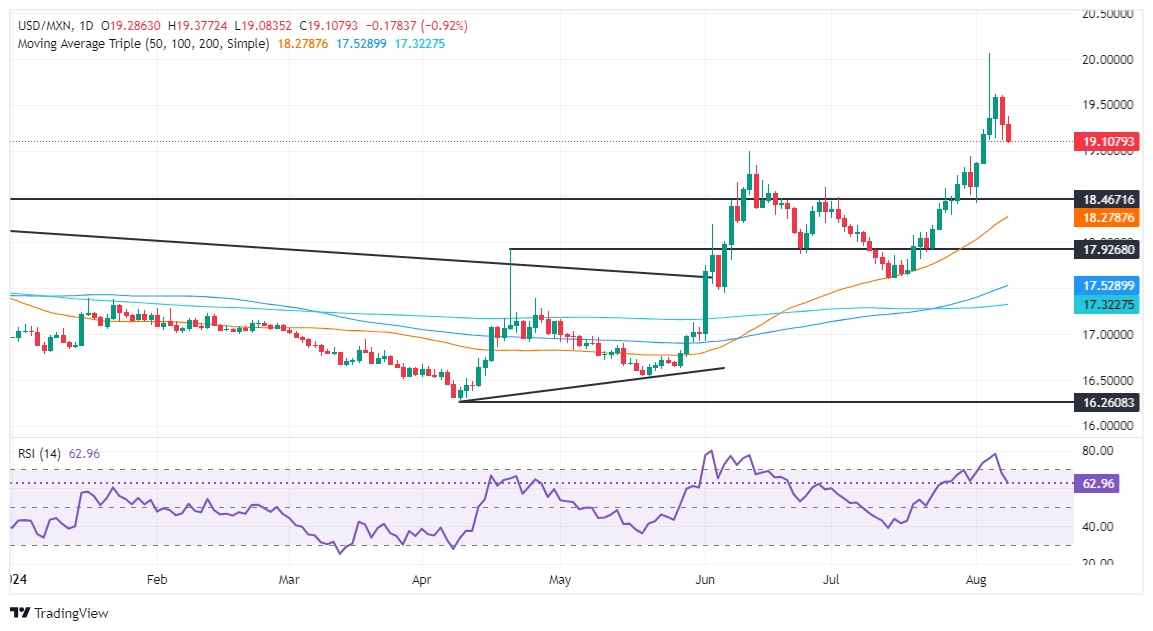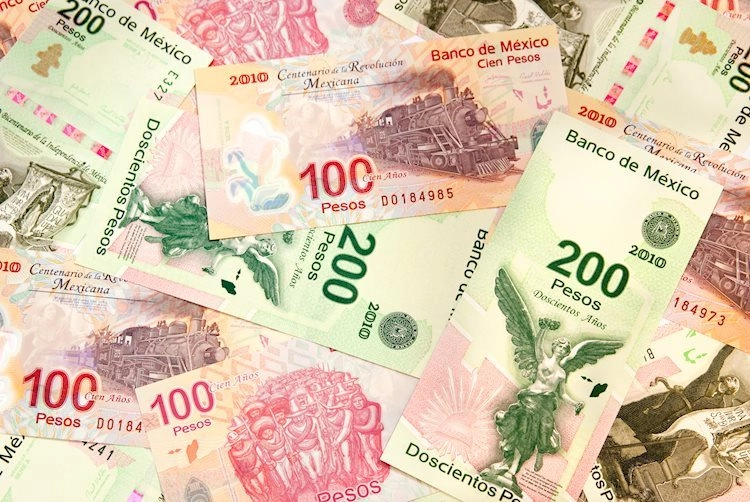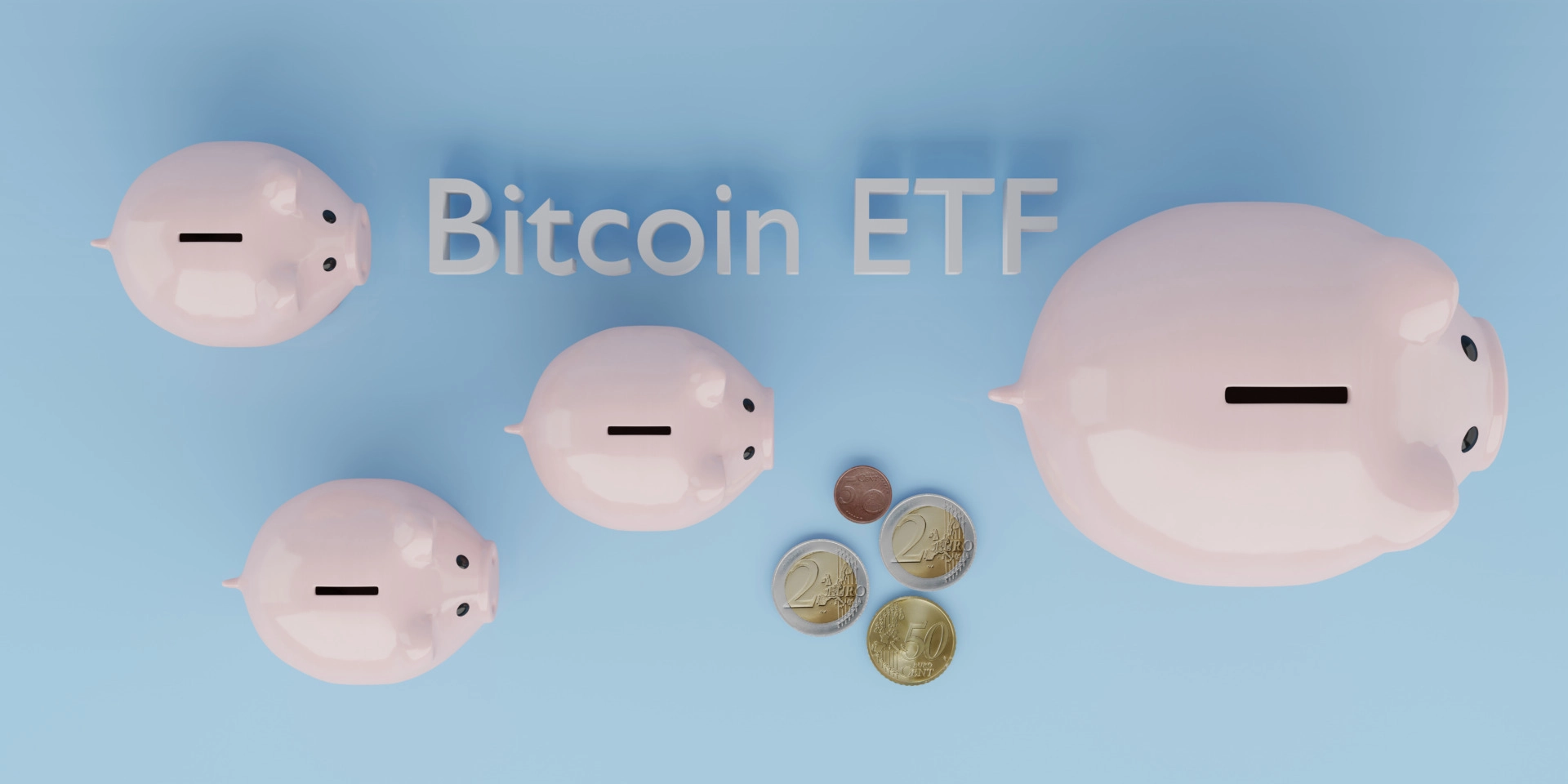- Mexican Peso extends its rally, following Banxico’s decision.
- Banxico cuts rates despite inflation rising to 5.57%; core inflation trends down.
- The Board anticipates further rate adjustments; inflation risks remain tilted to the upside.
The Mexican Peso strengthened against the Greenback on Thursday as the Bank of Mexico (Banxico) decided to lower borrowing costs from 11.00% to 10.75%, defying estimates of keeping the main reference rate unchanged. Despite that, the USD/MXN dropped to a four-day low of 18.89 before trimming some losses but remains below 19.00.
Governor Victoria Rodriguez Ceja and Deputy Governors Galia Borja and Omar Mejia Castelazo voted in favor of the decision. Meanwhile, Deputy Governors Irene Espinosa and Jonathan Heath voted in favor of keeping the main reference rate at 11.00%.
In its monetary policy statement, Banxico’s officials commented that despite July’s inflation rising to 5.57%, core figures “which better reflects the inflation trend, accumulated eighteen consecutive months of reductions, registering 4.05%.”
Forward guidance was maintained, meaning that further adjustments to the reference rate could be expected while emphasizing that inflationary risks are tilted to the upside. Regarding economic growth, risks are biased to the downside.
Banxico’s board updated their forecasts for inflation, with headlines expected to aim higher in the short term but remained unchanged for the longer term. Core inflation is expected to edge lower, and would dive below 4% in the fourth quarter of 2024.
The Mexican Peso rose in early trading in the North American session on Thursday after the Instituto Nacional de Estadistica Geografia e Informatica (INEGI) revealed that the Consumer Price Index (CPI) in July rose above estimates ahead of the Bank of Mexico's (Banxico) monetary policy decision. The USD/MXN trades at 19.15, down 0.70%.
Across the border, the number of Americans filing for unemployment benefits dipped below the consensus, bolstering the Greenback. So far, it has been up against most G7 currencies but failed to gain traction against the Mexican Peso.
Wall Street rallied as a relief that the labor market is not in a bad position. This follows last week’s Initial Jobless Claims report, followed by dismal Nonfarm Payrolls (NFP) figures.
Daily digest market movers: Mexican Peso rally extends after Banxico’s dovish tilt
- Mexico’s inflation rate rose 1.05% MoM, exceeded estimates of 1.02%, and crushed June’s 0.38%. In the 12 months to July rose from 4.98% to 5.57% as foreseen.
- Core prices ticked up from 0.22% to 0.32% MoM, above economists' projections of 0.29%. On an annual basis, however, inflation missed the 4.02% consensus but dipped to 4.05%, improving compared to June's 4.13%.
- Societe Generale expects Banxico to hold rates unchanged due to the Mexican Peso depreciation to 20.00 Pesos per US Dollar following NFP data. They noted that this “could be counter-productive to restoring stability and should be delayed.”
- On Friday, Mexico’s Industrial Production is expected to dip, which could put Banxico at a crossroads as headline inflation rises, while the economy stagnates.
- US Initial Jobless Claims for the week ending August 3 dipped from 250K to 233K, below forecasts of 240K. Continuing Claims through July 27 jumped from 1,869K to 1,875K, exceeding the forecast of 1870K.
- Banxico’s decision should influence the USD/MXN and the Fed. The CME FedWatch Tool shows the odds of a 50-basis-point interest rate cut by the Fed at the September meeting at 57.5%, down from 63.5% a day ago.
Technical analysis: Mexican Peso dives as USD/MXN hovers around 19.10
The USD/MXN drops to four-day lows of 19.08 as traders begin to price in Banxico keeping rates unchanged, clearing key support levels as the pair accelerated to the 19.00 psychological mark. Momentum remains in favor of buyers, but in the near term the Relative Strength Index (RSI) shows sellers have the upper hand.
If USD/MXN drops below 19.00, the next support would be the July 31 high at 18.94, before dropping to the August 1 low of 18.42. Once cleared, further losses await, with the 50-day Simple Moving Average (SMA) up next at 18.26.
Conversely, if USD/MXN climbs past 19.50, the next resistance would be 20.00. A decisive break will expose the YTD high at 20.22, followed by the 20.50 mark.

Mexican Peso FAQs
The Mexican Peso (MXN) is the most traded currency among its Latin American peers. Its value is broadly determined by the performance of the Mexican economy, the country’s central bank’s policy, the amount of foreign investment in the country and even the levels of remittances sent by Mexicans who live abroad, particularly in the United States. Geopolitical trends can also move MXN: for example, the process of nearshoring – or the decision by some firms to relocate manufacturing capacity and supply chains closer to their home countries – is also seen as a catalyst for the Mexican currency as the country is considered a key manufacturing hub in the American continent. Another catalyst for MXN is Oil prices as Mexico is a key exporter of the commodity.
The main objective of Mexico’s central bank, also known as Banxico, is to maintain inflation at low and stable levels (at or close to its target of 3%, the midpoint in a tolerance band of between 2% and 4%). To this end, the bank sets an appropriate level of interest rates. When inflation is too high, Banxico will attempt to tame it by raising interest rates, making it more expensive for households and businesses to borrow money, thus cooling demand and the overall economy. Higher interest rates are generally positive for the Mexican Peso (MXN) as they lead to higher yields, making the country a more attractive place for investors. On the contrary, lower interest rates tend to weaken MXN.
Macroeconomic data releases are key to assess the state of the economy and can have an impact on the Mexican Peso (MXN) valuation. A strong Mexican economy, based on high economic growth, low unemployment and high confidence is good for MXN. Not only does it attract more foreign investment but it may encourage the Bank of Mexico (Banxico) to increase interest rates, particularly if this strength comes together with elevated inflation. However, if economic data is weak, MXN is likely to depreciate.
As an emerging-market currency, the Mexican Peso (MXN) tends to strive during risk-on periods, or when investors perceive that broader market risks are low and thus are eager to engage with investments that carry a higher risk. Conversely, MXN tends to weaken at times of market turbulence or economic uncertainty as investors tend to sell higher-risk assets and flee to the more-stable safe havens.
Information on these pages contains forward-looking statements that involve risks and uncertainties. Markets and instruments profiled on this page are for informational purposes only and should not in any way come across as a recommendation to buy or sell in these assets. You should do your own thorough research before making any investment decisions. FXStreet does not in any way guarantee that this information is free from mistakes, errors, or material misstatements. It also does not guarantee that this information is of a timely nature. Investing in Open Markets involves a great deal of risk, including the loss of all or a portion of your investment, as well as emotional distress. All risks, losses and costs associated with investing, including total loss of principal, are your responsibility. The views and opinions expressed in this article are those of the authors and do not necessarily reflect the official policy or position of FXStreet nor its advertisers. The author will not be held responsible for information that is found at the end of links posted on this page.
If not otherwise explicitly mentioned in the body of the article, at the time of writing, the author has no position in any stock mentioned in this article and no business relationship with any company mentioned. The author has not received compensation for writing this article, other than from FXStreet.
FXStreet and the author do not provide personalized recommendations. The author makes no representations as to the accuracy, completeness, or suitability of this information. FXStreet and the author will not be liable for any errors, omissions or any losses, injuries or damages arising from this information and its display or use. Errors and omissions excepted.
The author and FXStreet are not registered investment advisors and nothing in this article is intended to be investment advice.





